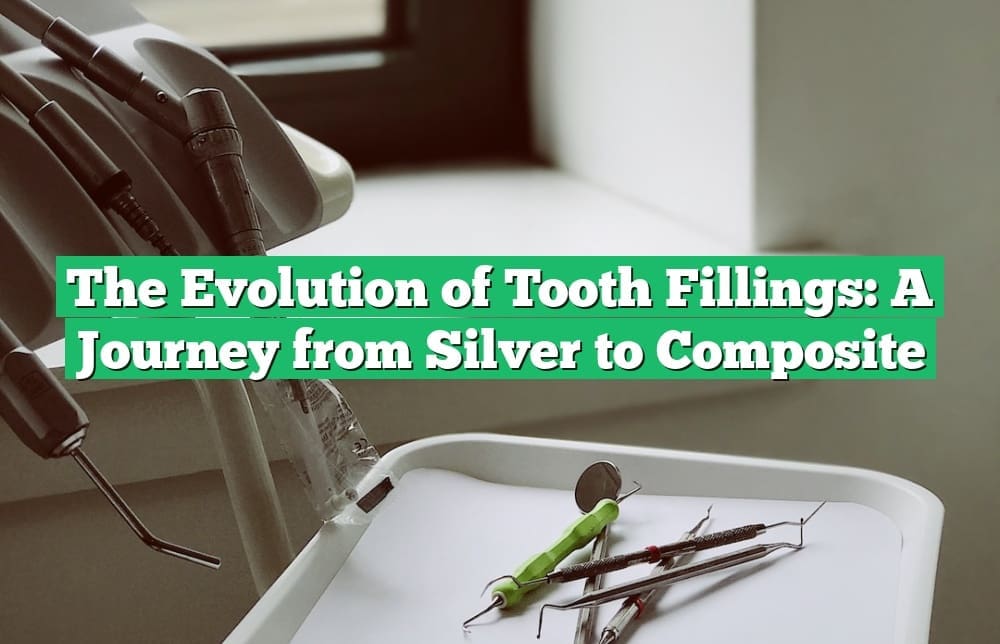Have you ever wondered how tooth fillings have evolved over time? From the traditional silver amalgam fillings to the more modern composite fillings, the journey has been a fascinating one. In this post, we’ll take a closer look at the evolution of tooth fillings and how they have improved over the years.
The History of Tooth Fillings and Their Early Materials
Tooth fillings have been around for centuries, with evidence of ancient civilizations using various materials to fill cavities. The earliest known dental fillings were made of beeswax, resin, and tar. These materials were not very durable and often fell out, leading to further decay and tooth loss.
In the 1800s, silver amalgam became the most popular filling material due to its durability and affordability. However, concerns about the safety of mercury in amalgam fillings have led to the development of alternative materials such as composite resin. These tooth-colored fillings are made of a mixture of plastic and glass and are more aesthetically pleasing than silver amalgam. To learn more about proactive dental care strategies that can help prevent the need for tooth fillings, check out Preventing the Need for Tooth Fillings: Proactive Dental Care Strategies.
As technology continues to advance, new materials and techniques for tooth fillings are being developed. However, the best way to avoid the need for fillings is to practice good oral hygiene, including brushing twice a day, flossing daily, and visiting the dentist regularly for cleanings and checkups. By taking a proactive approach to dental care, you can help keep your teeth healthy and avoid the need for fillings altogether.
The Rise of Silver Amalgam Fillings and Their Drawbacks
Silver amalgam fillings were once the go-to option for restoring decayed teeth. They were durable, long-lasting, and affordable. However, over time, concerns about the safety of silver amalgam fillings have arisen. These fillings contain mercury, which can be toxic to the body in high doses. Additionally, silver amalgam fillings are not aesthetically pleasing, as they are highly visible in the mouth and can cause discoloration of the surrounding tooth structure.
As a result, many patients are now opting for composite fillings, which are made of a tooth-colored resin material. Composite fillings are not only safer, but they also blend in seamlessly with the natural tooth structure, making them a more aesthetically pleasing option. If you are in need of tooth filling services, consider reaching out to our team of experts at Expert Tooth Filling Services in Snohomish. We offer a range of restorative dentistry services, including composite fillings, to help you achieve a healthy, beautiful smile.
The Development of Composite Resin Fillings and Their Advantages
Composite resin fillings were first introduced in the 1960s as an alternative to traditional silver amalgam fillings. These fillings are made of a mixture of plastic and glass, which allows them to be color-matched to the natural shade of the tooth. This makes them a more aesthetically pleasing option for those who want to maintain the appearance of their smile.
In addition to their cosmetic benefits, composite resin fillings also have several advantages over traditional silver fillings. They require less removal of healthy tooth structure, which means that more of the natural tooth can be preserved. They also bond directly to the tooth, which provides additional support and helps to prevent further decay.
Another advantage of composite resin fillings is that they are less likely to expand and contract with changes in temperature, which can cause cracking and damage to the tooth. This makes them a more durable and long-lasting option for those who want to maintain the health and integrity of their teeth.
Overall, the development of composite resin fillings has revolutionized the field of dentistry and provided patients with a more aesthetically pleasing, durable, and effective option for restoring their teeth.
The Future of Tooth Fillings and Emerging Technologies
As technology continues to advance, the future of tooth fillings looks promising. One emerging technology is the use of nanotechnology in dental fillings, which could potentially make them stronger and longer-lasting. Additionally, 3D printing is being explored as a way to create custom-fit fillings that perfectly match the shape and color of a patient’s teeth. Another exciting development is the use of stem cells to regenerate damaged tooth tissue, potentially eliminating the need for fillings altogether. As these technologies continue to evolve, the future of tooth fillings looks brighter than ever before.
The Impact of Tooth Fillings on Dental Health and Overall Well-being
Tooth fillings have played a significant role in maintaining dental health and overall well-being. They are used to treat cavities, prevent further decay, and restore the function of damaged teeth. In the past, silver amalgam fillings were the most commonly used material, but they have been replaced by composite fillings due to their aesthetic appeal and safety concerns. Composite fillings are made of a tooth-colored resin that blends seamlessly with the natural teeth, making them a popular choice for patients. The use of tooth fillings has helped to prevent tooth loss, reduce the risk of infection, and improve the overall quality of life for many individuals.
Conclusion
Don’t let myths and misconceptions about tooth fillings keep you from getting the dental care you need – call Pilchuck Family Dentistry at 360-800-2013 to schedule an appointment today, and check out our reviews on Google Maps.
